脉冲多普勒雷达
by Braden Riggs and George Williams (gwilliams@gsitechnology.com)
Braden Riggs和George Williams(gwilliams@gsitechnology.com)
In the world of data science the industry, academic, and government sectors often collide when enthusiasts and experts alike, work together to tackle the challenges we face day-to-day. A prime example of this collaboration is the Israeli Ministry of Defense Directorate of Defense Research & Development (DDR&D)’s MAFAT challenges. A series of data science related challenges with real-world application and lucrative prize pools. In the program’s own words:
在数据科学世界中,当发烧友和专家都共同努力应对我们日常面临的挑战时,行业,学术界和政府部门经常发生冲突。 以色列国防部国防研究与发展局(DDR&D)的MAFAT挑战就是这种合作的主要例证。 一系列与数据科学相关的挑战,包括现实应用和丰厚的奖池。 用程序本身的话来说:
The goal of the challenge is to explore the potential of advanced data science methods to improve and enhance the IMOD current data products. The winning method may eventually be applied to real data and the winners may be invited to further collaborate with the IMOD on future projects.- MAFAT Competition Coordinators
挑战的目标是探索先进数据科学方法的潜力,以改善和增强IMOD当前数据产品。 获奖方法可能最终会应用于真实数据,获奖者可能会被邀请在未来的项目上与IMOD进一步合作。- MAFAT竞赛协调员
Given the recent inception of the program, there haven’t been many challenges yet, however, there are expected to be a variety of challenges ranging from complicated Natural Language Processing puzzles to computer-vision related endeavors.
鉴于该程序是最近启动的,因此还没有很多挑战,但是,预计会出现各种各样的挑战,从复杂的自然语言处理难题到计算机视觉相关的工作。
One such challenge, their second one made available thus far, caught my eye. It involves creating a model for classifying living, non-rigid objects that have been detected by doppler-pulse radar systems. The challenge, “MAFAT Radar Challenge — Can you distinguish between humans and animals in radar tracks?” implores competitors to develop a model that can accurately distinguish humans from animals based on a spectrum of radio signals recorded from various doppler-pulse radar sites on various days. If you are interested in participating I recommend visiting the challenge site before reading on.
这样的挑战之一,到目前为止已经提供的第二个挑战引起了我的注意。 它涉及创建一个模型,以对多普勒脉冲雷达系统已检测到的活的非刚性物体进行分类。 挑战“ MAFAT雷达挑战-您能区分雷达轨道中的人与动物吗? 恳请竞争对手开发一种模型,该模型可以根据在不同日子从各个多普勒脉冲雷达站点记录的无线电信号频谱,准确地将人与动物区分开。 如果您有兴趣参加,我建议您访问 在继续阅读之前先挑战网站 。
那么,我们正在处理什么样的数据?我们需要了解什么? (So what kind of data are we working with and what do we need to know about it?)
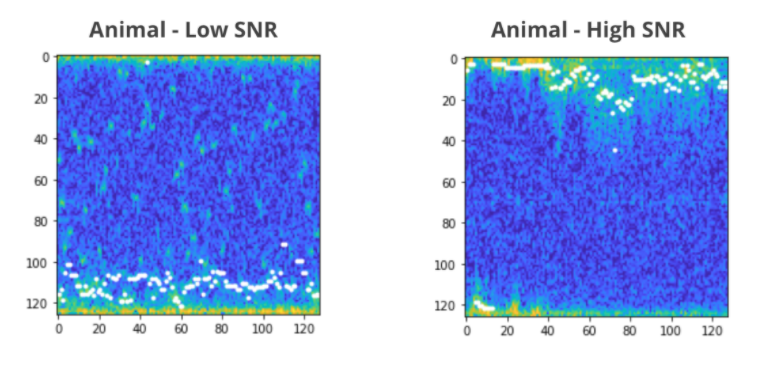
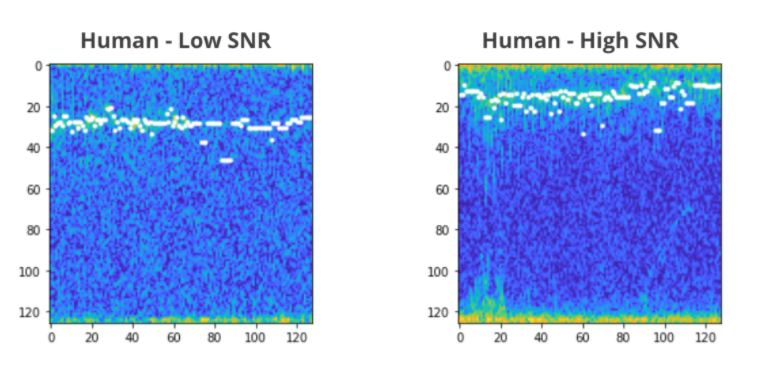
The key to developing an accurate and competitive model is to first understand the data, how it was sourced, and what it is missing. Included with the competition is 5 CSV files containing the metadata, and 5 pickle files (serializing Python object structure format) containing doppler readings that track the object’s center of mass and slow/fast time readings in the form of a standardized I/Q matrix.
开发准确而具有竞争力的模型的关键是首先了解数据,数据来源和缺失内容。 竞赛中包括5个包含元数据的CSV文件 ,以及5个 包含多普勒读数的 pickle文件 (序列化Python对象结构格式) ,它们以标准化I / Q矩阵的形式跟踪对象的质心和慢/快时间读数 。
Before we go any further it is worth breaking down a few key concepts relating to signals and the specific types of data collected. The signal readings that make up the dataset fall into two levels of quality, High Signal to Noise Ratio, and Low Signal to Noise Ratio. This reading, High SNR and Low SNR divides the set into two levels of quality, one with high clarity that hasn’t been heavily tainted by a noise generating process, and one with low clarity that has had aspects such as weather impact the quality of the reading.
在进一步研究之前,有必要分解一些与信号和所收集数据的特定类型有关的关键概念。 构成数据集的信号读数分为两个质量级别,即高信噪比和低信噪比 。 该读数分为高信噪比和低信噪比两类,将质量分为两个级别,一个级别的高清晰度没有受到噪声生成过程的严重影响,而另一个级别的低清晰度却受到天气等因素的影响。阅读。
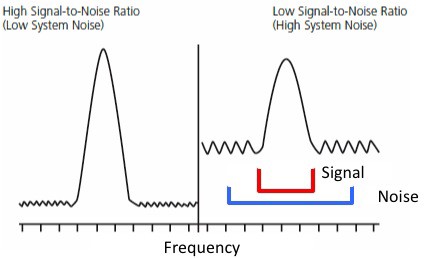
You might be wondering why we would even choose to include low SNR readings given the impact noise has on the data, however to my surprise this data is actually quite valuable when developing an effective model. Real-life is messy, and the true reading one might expect to see will not always be high quality, hence it is important to make sure our model is adaptive and geared towards a range of data readings, not just the highest quality ones. Furthermore, we are working with a limited amount of data (which we will explore in-depth below) and hence want to utilize everything at our disposal for training the model.
您可能想知道为什么考虑到噪声对数据的影响,我们为什么甚至选择包括低SNR读数,但是令我惊讶的是,在开发有效模型时,该数据实际上非常有价值。 现实生活是一团糟,人们可能期望看到的真实读数并不总是高质量的,因此,重要的是要确保我们的模型具有自适应性,并且适合各种数据读数,而不仅仅是高质量的读数。 此外,我们正在处理数量有限的数据(我们将在下面深入探讨),因此希望利用我们掌握的所有信息来训练模型。
Another series of concepts worth understanding is the notion of an I/Q matrix and what a doppler reading entails. An I/Q matrix consists of an N x M matrix, in our case a 32 x 128 matrix, that stores the slow and fast signal readings as cartesian elements, where “I” represents the real part and “M” represents the imaginary part. You can picture each row of this matrix as representing a signal pulse from the source, and each column of this matrix representing a reading for returning radio waves that have bounced off objects or targets in the direction of interest. The time between pulses is “slow time” and the time between readings of said pulses is considered “fast time”, if you are still confused or further interested I highly recommend you follow this link for more information.
值得理解的另一系列概念是I / Q矩阵的概念以及多普勒读数的含义。 I / Q矩阵由N x M矩阵(在我们的示例中为32 x 128矩阵)组成,该矩阵将笛卡尔元素的慢和快信号读数存储为笛卡尔元素,其中“ I”代表实部,“ M”代表虚部。 您可以将矩阵的每一行表示为代表来自源的信号脉冲,并将矩阵的每一列表示为用于返回沿感兴趣方向从物体或目标反弹的无线电波的读数。 脉冲之间的时间为“慢时间”,而所述脉冲之间的时间间隔为“快速时间”,如果您仍然感到困惑或对此有进一步的兴趣,我强烈建议您点击此链接以获取更多信息。

Also included in the dataset, separate from the I/Q matrix, is the doppler burst readings. Consisting of one row of 128 readings the doppler burst can be used to track an object’s speed and direction of travel. Much like how the sirens on a police car change sound as the car drive past you, the doppler effect relates to the range in wavelength characteristics of objects in motion. By bouncing radio signals off objects of interest we can see how the radio waves change shape and hence infer a number of parameters about the object of interest such as speed, direction, and acceleration.
与I / Q矩阵分开的数据集中还包括多普勒猝发读数。 由128个读数的一行组成,多普勒脉冲串可用于跟踪物体的速度和行进方向。 就像警车上的警笛声一样,当汽车驶过您时,多普勒效应与运动物体的波长特性范围有关。 通过将无线电信号弹离目标物体,我们可以看到无线电波如何改变形状,从而推断出有关目标物体的许多参数,例如速度,方向和加速度。
Great, now that we have a bit of terminology under our belt it is time to discuss the five file pairs provided for the competition. These file pairs, whilst in the same format, differ from each other greatly and form five distinct sets:
太好了,现在我们有了一些专业术语,现在该讨论为比赛提供的五对文件了。 这些文件对虽然格式相同,但彼此之间有很大差异,并形成五个不同的集合:
Training set: As the name describes, the training set consists of a combination of human and animal, with high and low SNR readings created from authentic doppler-pulse radar recordings.
训练集:顾名思义,训练集由人和动物组成,具有由真实的多普勒脉冲雷达记录创建的高和低SNR读数。
Training set: As the name describes, the training set consists of a combination of human and animal, with high and low SNR readings created from authentic doppler-pulse radar recordings.6656 Entries
训练集:顾名思义,训练集由人和动物组成,具有从真实的多普勒脉冲雷达记录创建的高和低SNR读数。 6656个条目
Test set: For the purposes of the competition, a test set is included to evaluate the quality of the model and rank competitors. The set is unlabeled but does include a balanced mix of high and low SNR.
测试集:出于竞争目的,其中包括一个测试集,用于评估模型的质量并为竞争对手排名。 该集合未标记,但包含高和低SNR的平衡混合。
Test set: For the purposes of the competition, a test set is included to evaluate the quality of the model and rank competitors. The set is unlabeled but does include a balanced mix of high and low SNR.106 Entries
测试集:出于竞争目的,其中包括一个测试集,用于评估模型的质量并为竞争对手排名。 该集合未标记,但包含高和低SNR的平衡混合。 106条目
Synthetic Low SNR set: Using readings from the training set a low SNR dataset has been artificially created by sampling the high SNR examples and artificially populating the samples with noise. This set can be used to better train the model on low SNR examples.
合成低信噪比集:使用训练集中的读数,通过对高信噪比示例进行采样并用噪声人工填充样本来人工创建低信噪比数据集。 此集合可用于在低SNR实例上更好地训练模型。
Synthetic Low SNR set: Using readings from the training set a low SNR dataset has been artificially created by sampling the high SNR examples and artificially populating the samples with noise. This set can be used to better train the model on low SNR examples.50883 Entries
合成低信噪比集:使用训练集中的读数,通过对高信噪比示例进行采样并用噪声人工填充样本来人工创建低信噪比数据集。 此集合可用于在低SNR实例上更好地训练模型。 50883条目
The Background set: The background dataset includes readings gathered from the doppler-pulse radars without specific targets. This set could be used to help the model better distinguish noise in the labeled datasets and help the model distinguish relevant information from messy data.
背景集:背景数据集包括从多普勒脉冲雷达收集的,没有特定目标的读数。 该集合可用于帮助模型更好地区分标记数据集中的噪声,并帮助模型将相关信息与混乱数据区分开。
The Background set: The background dataset includes readings gathered from the doppler-pulse radars without specific targets. This set could be used to help the model better distinguish noise in the labeled datasets and help the model distinguish relevant information from messy data.31128 Entries
背景集:背景数据集包括从多普勒脉冲雷达收集的,没有特定目标的读数。 该集合可用于帮助模型更好地区分标记数据集中的噪声,并帮助模型从混乱数据中区分相关信息。 31128个条目
The Experiment set: The final set and possibly the most interesting, the experiment set includes humans recorded by the doppler-pulse radar in a controlled environment. Whilst not natural this could be valuable for balancing the animal-heavy training set provided.
实验装置:最终装置,也许是最有趣的装置,该实验装置包括多普勒脉冲雷达在受控环境中记录的人类。 这虽然不自然,但对于平衡提供的大量动物训练集可能很有价值。
The Experiment set: The final set and possibly the most interesting, the experiment set includes humans recorded by the doppler-pulse radar in a controlled environment. Whilst not natural this could be valuable for balancing the animal-heavy training set provided.49071 Entries
实验装置:最终装置,也许是最有趣的装置,该实验装置包括多普勒脉冲雷达在受控环境中记录的人类。 这虽然不自然,但对于平衡提供的大量动物训练集可能很有价值。 49071条目
As I have already alluded to, the training set isn’t populated with a satisfactory amount of data points. This constitutes the challenge, generating a sufficient amount of data to train the model on, from the supplementary synthetic, background, and experimental sets. This challenge is further exacerbated by the imbalance of the data.
正如我已经提到的,训练集中没有填充令人满意的数据点。 这就构成了挑战,需要从补充的合成,背景和实验集中生成足够数量的数据来训练模型。 数据不平衡进一步加剧了这一挑战。
With such a small dataset it is important to ensure the data is balanced and unbiased as this can lead to significant misinterpretations of the set by the model, and small inconsistencies can get extrapolated into significant errors.
使用如此小的数据集,重要的是要确保数据平衡且无偏见,因为这可能导致模型对集合的严重误解,并且小的不一致性可能会推断出重大错误。
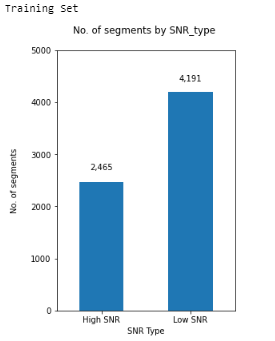
The first key imbalance is the difference between the number of high and low SNR tracks. As you can see from the adjacent graph there are almost two thousand more low SNR data points than high SNR.
第一个关键失衡是高和低SNR磁道数之间的差异。 从相邻的图表中可以看到,低SNR数据点比高SNR多了近两千。
|
|
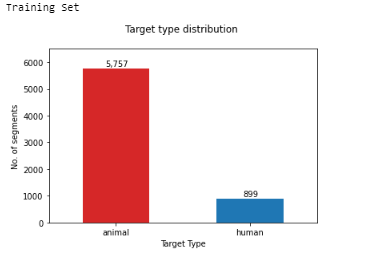
The second key imbalance is between the number of Humans and Animals in the dataset. Clearly, with such a significant difference the model might become biased towards predicting animal instead of human, since this prediction would net a high accuracy for little effort on the model’s part.
第二个关键的不平衡是数据集中的人类和动物数量之间。 显然,由于存在这种显着差异,因此该模型可能会偏向于预测动物而不是人类,因为这种预测将为模型方面付出很少的努力而获得很高的准确度。
|
|

Both of these disparities cause significant issues when building the model. If we take a closer look at the relationship between signal quality and target type we see that the majority of animals have low SNR readings and the majority of humans have high SNR readings. Whilst this may seem minor, extrapolated over a number of training intervals our model may make the mistake of conflating a cleaner signal with that of a human, and a noisy signal with that of an animal.
建立模型时,这两个差异都会导致严重问题。 如果我们仔细研究信号质量和目标类型之间的关系,我们会发现大多数动物的SNR读数较低,而大多数人的SNR读数较高。 尽管这似乎很小,但在许多训练间隔中推断出来,我们的模型可能会犯错误,将较干净的信号与人的信号混淆,而将噪声信号与动物的信号混淆。
|
|
基准模型和初始印象: (The Baseline Model and Initial Impressions:)
Interestingly enough, along with the data provided, a baseline model was included for the competitors. This model serves as an example of how the final submission should be formatted as well as providing a relative starting point for competitors. So what is the baseline model?
有趣的是,连同所提供的数据,还包括了针对竞争对手的基线模型。 该模型是如何格式化最终提交文件以及为竞争对手提供相对起点的示例。 那么基线模型是什么?
The MAFAT challenge organizers decided to start strong by beginning with Convolutional Neural Network (CNN), a form of artificial intelligence designed for computer vision problems. The model takes an input image and weights parameters based on their importance in discerning the final result, which in our case would be an animal or a human. This particular CNN has two convolutional layers, followed by two max-pooling layers, which again is followed by two “dense” layers, before finally being activated by a ReLU function and regularized with a Sigmoid function. This is better visualized with a diagram:
MAFAT挑战赛组织者决定从强大的卷积神经网络(CNN)开始 ,这是为计算机视觉问题设计的一种人工智能形式。 模型根据输入在识别最终结果中的重要性来获取输入图像和权重参数,在我们的例子中,该结果将是动物或人类。 这个特定的CNN具有两个卷积层 ,然后是两个最大池化层 ,然后又是两个“密集”层 ,最后由ReLU函数激活并由 Sigmoid函数进行正则化。 使用图表可以更好地将其可视化:
As you can see in the above diagram we start with the 126x32 I/Q matrix. This matrix, along with 15 others, are aligned, and the first convolution of training happens, of which the result is altered and resized to a different dimensionality. Eventually, the model concludes with a single value, a number somewhere between 0 and 1 where the closer to 0 the more likely the signal is an animal, and the closer to 1 the more likely the signal is human. It is alright if you don’t understand the logic or the terminology behind this baseline model, these techniques are quite elaborate and if I were to go into detail this blog would be twice as long. If you are interested this link goes into more detail.
如上图所示,我们从126x32 I / Q矩阵开始。 该矩阵与其他15个矩阵对齐,并且发生了第一次训练卷积,其结果被更改并调整为不同的维度。 最终,模型以单个值结束,该数字介于0到1之间,其中数字越接近0,表示该信号越可能是动物,而数字越接近1,则表示该信号更可能是人类。 如果您不了解此基准模型背后的逻辑或术语,那也没关系,这些技术都非常详尽,如果我要详细介绍,那么此博客的时间将是原来的两倍。 如果您有兴趣,请访问此链接 。
In addition to the model, the baseline attempt includes a few other noteworthy strategies for increasing the accuracy of prediction. As discussed earlier the training set is heavily imbalanced, to help amend this discrepancy the training set is supplemented with more data from the experiment set. This is to help the CNN understand and recognize human patterns within the data and will ideally lead to a higher level of accuracy. In our own attempt, we trained the model without changing the baseline structure, and validated (scored the accuracy of the model) on a sample of the training data withheld from the model. The results are visualized below:
除模型外,基线尝试还包括其他一些值得注意的策略,可以提高预测的准确性。 如前所述,训练集严重失衡,为了帮助纠正这种差异,训练集还添加了来自实验集的更多数据。 这是为了帮助CNN了解和识别数据中的人为模式,并且理想情况下将导致更高的准确性。 在我们自己的尝试中,我们在不更改基线结构的情况下对模型进行了训练,然后对从模型中保留的训练数据样本进行了验证(对模型的准确性进行评分)。 结果显示如下:
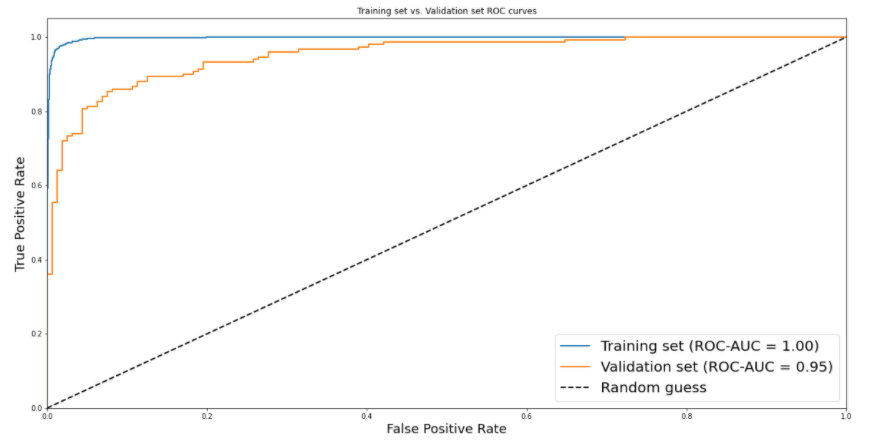
As you can see from the results the model performed perfectly on the training data, and almost perfectly on the validation set. For a baseline model, this is pretty impressive, right? Well as it turns out, by the admission of MAFAT themselves, the baseline model doesn’t perform well on the test set, averaging only a 75% accuracy. Given the scope of the project and the technology they are trying to produce, 75% simply won’t cut it. Hence we have to go back to the drawing board to figure out how we can create a more accurate model.
从结果中可以看出,该模型在训练数据上表现完美,在验证集上表现几乎完美。 对于基准模型,这是非常令人印象深刻的,对吗? 事实证明,通过MAFAT本身的接受,基线模型在测试集上的表现不佳,平均准确性仅为75%。 考虑到项目范围和他们试图生产的技术,75%根本不会削减。 因此,我们必须回到制图板上,找出如何创建更准确的模型。
什么不起作用,我们可以看到一种模式吗? (What isn’t working and can we see a pattern?)
So now that we understand how the baseline model works we need to understand what kind of mistakes the model is making on the test data. The best way to understand these patterns and the mistakes made by the model is to visualize the data, although this is easier said than done. Because of the high dimensionality of the data, it can be hard to visualize and understand in a meaningful way. Luckily for us, there is a solution to this problem, T-distributed Stochastic Neighbor Embedding for high dimensional data, also known as TSNEs. A TSNE is essentially its own machine learning algorithm for non-linear dimension reduction. It works by constructing a probability distribution over the different pairings of data where higher probabilities can be imagined as pairings of higher similarity. As the TSNE function continues it repeats this process, slowly predicting dimensionality until it reaches a stage where it is digestible to the human brain. Our code for producing the TSNE, along with the baseline notebook can be found here. In our case, we extracted the vector representation of the spectrogram using the final layer of the network before classification and computed the TSNE on the resulting vector.
因此,既然我们了解了基准模型的工作原理,我们就需要了解该模型在测试数据上犯了什么样的错误。 理解这些模式和模型所犯错误的最好方法是可视化数据,尽管说起来容易做起来难。 由于数据的高维度,可能很难以有意义的方式可视化和理解。 幸运的是,对于这个问题,有一个解决方案,即针对高维数据的T分布随机邻居嵌入,也称为TSNE。 TSNE本质上是其自己的用于非线性降维的机器学习算法。 它通过在不同数据对上构建概率分布来工作,其中较高的概率可以想象为较高相似性的对。 随着TSNE功能的继续,它会重复此过程,慢慢预测维数,直到达到人脑可消化的阶段。 我们用于生产TSNE的代码以及基准笔记本 可以在这里找到。 在我们的案例中,我们提取了 在分类之前使用网络的最后一层对频谱图进行矢量表示,并在生成的矢量上计算TSNE。
Because of the stochastic nature of the algorithm, TSNE’s look different every time they are computed, however, they are useful for pointing out noteworthy clusters of similar data. Computing the TSNE for our model produces the following plot where:
由于该算法具有随机性,因此每次计算时,TSNE的外观都会有所不同,但是,它们对于指出相似数据的值得注意的簇很有用。 为我们的模型计算TSNE会产生以下图,其中:
Green = animalBlue = humanRed = incorrect prediction in the validation setTeal = location of a test set value
绿色=动物蓝色=人类红色=验证集中的预测不正确Teal =测试集值的位置
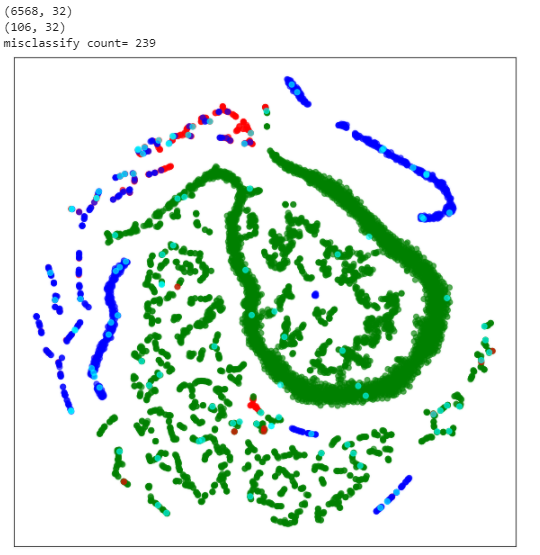
As you can see there are some pretty significant clusters of animals and a few clusters of humans. Because there are fewer humans in the training set the human clusters are less apparent when compared to the animal clusters. As indicated by the red points there are a few areas where the model makes incorrect predictions. This is noteworthy because it appears as though the red points form two distinct clusters themselves, suggesting that the majority of incorrectly predicted points are close to two separate epicenters. What is also noteworthy is that there are a significant number of teal points that also fall in these regions, which explains why the baseline model is only scoring around ~75%, because the model would be incorrectly predicting these points.
如您所见,这里有一些非常重要的动物群和一些人类群。 由于训练集中的人较少,因此与动物群相比,人群的明显性较低。 如红色点所示,模型在一些区域进行了错误的预测。 这是值得注意的,因为它看起来好像红点本身形成了两个不同的簇,这表明大多数错误预测的点都靠近两个单独的震中。 还值得注意的是,在这些区域中也有大量的蓝绿色点,这解释了为什么基线模型仅得分在〜75%左右,因为模型会错误地预测这些点。
It also appears that the test set is relatively spread out not forming as clear of a center and being relatively even between animals and humans, although we can’t know this for sure as we don’t possess the labels for points at those locations.
似乎测试集也相对分散,没有形成清晰的中心,并且在动物和人之间相对均匀,尽管我们不能确切知道这一点,因为我们在那些位置没有点的标签。
下一步: (Where to next:)
Given this information, there are a number of different strategies we can explore for boosting the overall quality of the model or in creating a different model altogether. In an ideal world, we would have a larger training dataset, this would be a great solution to the problem as the more points we have to train on, the more chance the model has of understanding a pattern that can lead to the correct classification of the red clusters above. Unfortunately, this isn’t an option and we are limited to the data provided or any data we can gather from external sources. This seems like a good place to start because the distribution is so unbalanced between humans, animal, low SNR, and high SNR. By developing a better distribution of data, be that from the auxiliary sets provided, or from some external source, we can retrain the model and see how the results improve. Depending on the performance of the baseline model on a more balanced dataset, we can then move forward towards creating an improved model.
有了这些信息,我们可以探索许多不同的策略来提高模型的整体质量或完全创建不同的模型。 在理想的世界中,我们将拥有一个更大的训练数据集,这将是一个很好的解决方案,因为我们必须训练的点越多,该模型就越有机会理解可以正确分类的模式。上面的红色簇。 不幸的是,这不是一种选择,我们仅限于提供的数据或我们可以从外部来源收集的任何数据。 这似乎是一个不错的起点,因为人,动物,低SNR和高SNR之间的分布非常不平衡。 通过开发更好的数据分布,无论是从提供的辅助集中还是从某些外部来源,我们都可以重新训练模型并查看结果如何改善。 根据基线模型在更平衡的数据集上的性能,然后我们可以朝着创建改进的模型前进。
As I write this now some competitors have already scored accuracies greater than 95%. A leader board of competitors and their scores can be found here. This is a multipart series with more updates to come as we proceed through the competition.
在撰写本文时,一些竞争对手的准确度已超过95%。 一个 竞争对手排行榜及其分数可在此处找到。 这是一个分为多个部分的系列,随着比赛的进行,将会有更多更新。
资料来源和其他阅读: (Sources and Additional Reading:)
IQ Modulation. (n.d.). Retrieved August 13, 2020, from https://www.keysight.com/upload/cmc_upload/All/IQ_Modulation.htm?cmpid=zzfindnw_iqmod
智商调制。 (nd)。 于2020年8月13日从https://www.keysight.com/upload/cmc_upload/All/IQ_Modulation.htm?cmpid=zzfindnw_iqmod检索
Saha, S. (2018, December 17). A Comprehensive Guide to Convolutional Neural Networks — the ELI5 way. Retrieved August 13, 2020, from https://towardsdatascience.com/a-comprehensive-guide-to-convolutional-neural-networks-the-eli5-way-3bd2b1164a53
Saha,S.(2018年12月17日)。 卷积神经网络综合指南-ELI5方法。 于2020年8月13日从https://towardsdatascience.com/a-comprehensive-guide-to-convolutional-neural-networks-the-eli5-way-3bd2b1164a53检索
Understanding I/Q Signals and Quadrature Modulation: Radio Frequency Demodulation: Electronics Textbook. (n.d.). Retrieved August 13, 2020, from https://www.allaboutcircuits.com/textbook/radio-frequency-analysis-design/radio-frequency-demodulation/understanding-i-q-signals-and-quadrature-modulation/
了解I / Q信号和正交调制:射频解调:电子教科书。 (nd)。 于2020年8月13日从https://www.allaboutcircuits.com/textbook/radio-frequency-analysis-design/radio-frequency-demodulation/understanding-iq-signals-and-quadrature-modulation/检索
What is I/Q Data? (n.d.). Retrieved August 13, 2020, from http://www.ni.com/tutorial/4805/en/
什么是I / Q数据? (nd)。 于2020年8月13日从http://www.ni.com/tutorial/4805/en/检索
All images used are either created by myself or used with the explicit permission of the authors. Links to the author’s material are included under each image.
所有使用的图像要么由我自己创建,要么在作者的明确许可下使用。 每个图像下方都包含指向作者资料的链接。
脉冲多普勒雷达







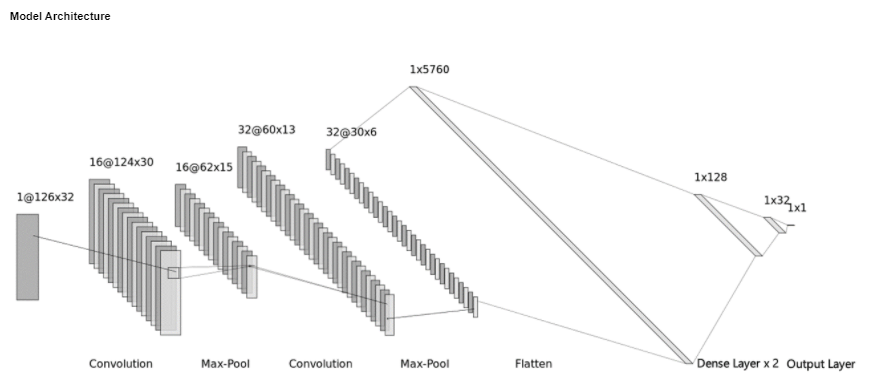
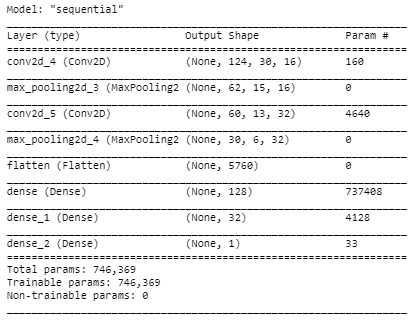













 6545
6545











 被折叠的 条评论
为什么被折叠?
被折叠的 条评论
为什么被折叠?








